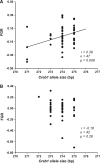Candidate genes have sex-specific effects on timing of spring migration and moult speed in a long-distance migratory bird
- PMID: 29492007
- PMCID: PMC5804205
- DOI: 10.1093/cz/zow103
Candidate genes have sex-specific effects on timing of spring migration and moult speed in a long-distance migratory bird
Abstract
The timing of major life-history events, such as migration and moult, is set by endogenous circadian and circannual clocks, that have been well characterized at the molecular level. Conversely, the genetic sources of variation in phenology and in other behavioral traits have been sparsely addressed. It has been proposed that inter-individual variability in the timing of seasonal events may arise from allelic polymorphism at phenological candidate genes involved in the signaling cascade of the endogenous clocks. In this study of a long-distance migratory passerine bird, the willow warbler Phylloscopus trochilus, we investigated whether allelic variation at 5 polymorphic loci of 4 candidate genes (Adcyap1, Clock, Creb1, and Npas2), predicted 2 major components of the annual schedule, namely timing of spring migration across the central Mediterranean sea and moult speed, the latter gauged from ptilochronological analyses of tail feathers moulted in the African winter quarters. We identified a novel Clock gene locus (Clock region 3) showing polyQ polymorphism, which was however not significantly associated with any phenotypic trait. Npas2 allele size predicted male (but not female) spring migration date, with males bearing longer alleles migrating significantly earlier than those bearing shorter alleles. Creb1 allele size significantly predicted male (but not female) moult speed, longer alleles being associated with faster moult. All other genotype-phenotype associations were statistically non-significant. These findings provide new evidence for a role of candidate genes in modulating the phenology of different circannual activities in long-distance migratory birds, and for the occurrence of sex-specific candidate gene effects.
Keywords: Adcyap1; avian migration; candidate genes; clock; phenology; ptilochronology.
Figures


References
-
- Bazzi G, Cecere JGC, Caprioli M, Gatti E, Gianfranceschi L. et al., in press. Clock gene polymorphism, migratory behaviour and geographic distribution: a comparative study of trans-Saharan migratory birds. Molecular Ecology. - PubMed
-
- Bensch S, Andersson T, Åkesson S, 1999. Morphological and molecular variation across a migratory divide in willow warblers, Phylloscopus trochilus. Evolution 53:1925–1935. - PubMed
LinkOut - more resources
Full Text Sources
Other Literature Sources
